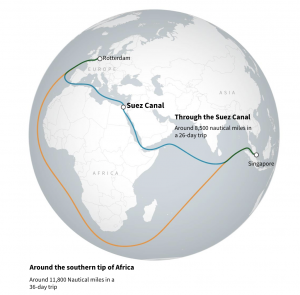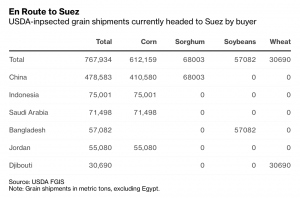Bloomberg's Clarice Couto reported this past Friday that "a surprising tax change in agriculture powerhouse Brazil has the potential to make soy grown in the world’s largest bean exporter less…
Suez Canal Blockage- Grain, Livestock Impacts Noted
Last week, New York Times writers Vivian Yee and Peter S. Goodman reported that, “Trying to convey the sheer scale of the nearly quarter-mile-long container ship that has been stuck in the Suez Canal since Tuesday evening, some news outlets compared it to the length of four soccer fields. Others simply called it gigantic.
“But the main thing to know was this: After powerful winds forced the ship aground on one of the canal’s banks, it was big enough to block nearly the entire width of the canal, producing a large traffic jam in one of the world’s most important maritime arteries.
“By Wednesday morning, more than 100 ships were stuck at each end of the 120-mile canal, which connects the Red Sea to the Mediterranean and carries roughly 10 percent of worldwide shipping traffic. Only the Panama Canal looms as large in the global passage of goods.”

The Times article explained that, “The potential fallout is vast. The vessels caught in the bottleneck or expected to arrive there in the coming days include oil tankers carrying about one-tenth of a day’s total global oil consumption, according to Kpler, a market research firm, to say nothing of the rest of the cargo now waiting to traverse the canal.
And if the ship is not freed within a few days, it would add one more burden to a global shipping industry already reeling from the coronavirus pandemic, creating delays, shortages of goods and higher prices for consumers.
On Saturday, Wall Street Journal writers Summer Said, Costas Paris and Stephen Kalin reported that, “Shipping experts warn it could take days, if not weeks, before movement returns to normal.”
“Shipping operators involved in the logjam estimate $12 billion of cargo is on vessels stranded at other points along the 120-mile canal or idling just outside it. Avoiding the passageway by sailing around Africa can add two weeks and hundreds of thousands of dollars in freight costs per voyage. As a result, shipping and oil prices have risen, and the already-pressured logistics industry will likely face delays and extra costs,” the Journal article said.

More narrowly with respect to agriculture, Bloomberg writer Kevin Varley reported on Friday that,
The congestion of the Suez Canal, caused by a stranded container ship, may delay nearly 7% of seaborne U.S. major grain shipments, according to USDA and vessel data analyzed by Bloomberg.
Mr. Varley added that, “More than 80% of the impacted grain shipments are corn, with close to 60% of it on six vessels headed to China. At least one vessel, the Ledra, hauling corn to Vietnam, recently diverted toward the Cape Route around South Africa.”

And Bloomberg writers Michael Hirtzer, Megan Durisin, and Sergio Chapa reported on Friday that, “Of all the millions of tons of cargo that’s piled up in the Suez Canal, none is more delicate than the animals crammed into the hulls of several of the ships.
“Little information is available, with neither canal officials nor shipping executives willing to talk, but data compiled by Bloomberg indicate as many as 14 vessels stuck in and around the canal could be carrying thousands of livestock. Given the Europe-to-Middle East itineraries of many, they are most likely carrying sheep. Ships carrying 92,000 animals to Jordan are stranded, an official said.”
The Bloomberg writers pointed out that, “While much of the waylaid cargo is commodity products such as oil that can be stored on ships for long periods, livestock need food and water, and such deliveries usually carry only enough for a few extra days. That could create a critical situation for ships to find feed supplies at a local port, or force them to turn around. Dislodging the vessel blocking the canal may take at least a week, longer than initially feared, people familiar with the matter said.”
Meanwhile, David Sheppard, Harry Dempsey, Heba Saleh, Leo Lewis and Kana Inagaki reported on Monday that, “The skyscraper-sized container ship that has been stuck in the Suez Canal for almost a week was finally freed on Monday, with the vessel starting to move north following a dramatic rescue mission to reopen one of the world’s main trade arteries.
“Tugboats involved in the rescue sounded their horns as the bow of the Ever Given container ship was released from the eastern canal bank shortly after 2pm London time on Monday. Leth Agencies, a transit agent in the Suez Canal, said the vessel was moving north to the Great Bitter Lake portion of the Suez Canal.”
It's moving!
— Bloomberg Quicktake (@Quicktake) March 29, 2021
The Ever Given ship stuck in the Suez Canal was finally pulled free. The ship is moving north from where it was grounded https://t.co/v9WprWuKbS pic.twitter.com/iX9kt8A9m8
The FT article stated that, “Boskalis, the Dutch company fronting the rescue of the ship, had earlier warned there was only a 70 per cent chance of freeing the vessel this week after the stern of the ship was moved overnight, cautioning that it was still badly stuck.
“But efforts to free the bow from heavy clay soil on Monday afternoon were successful, potentially allowing the speedy reopening of the waterways to international shipping traffic.”
However, Reuters News reported on Monday that, “The stranding of a container ship in the Suez Canal has created disruptions in the global shipping industry that could take weeks and possibly months to clear, top container shipping lines said.
“Around 30% of the world’s shipping container volume – including goods like sofas, consumer electronics, apparel and shoes – moves through the 193 km (120 miles) Suez Canal daily. Empty containers, which Asian factories need to ship goods, are also caught up in the backlog.
“‘Even when the canal gets reopened, the ripple effects on global capacity and equipment are significant,’ the world’s largest container shipping company Maersk said in a customer advisory on Monday.”







